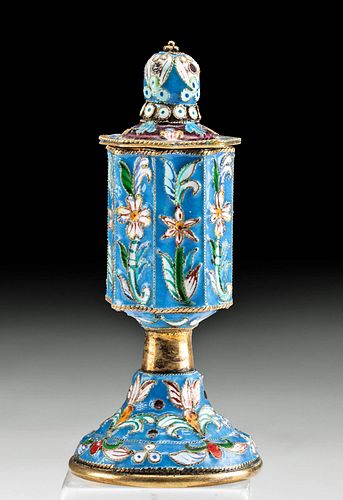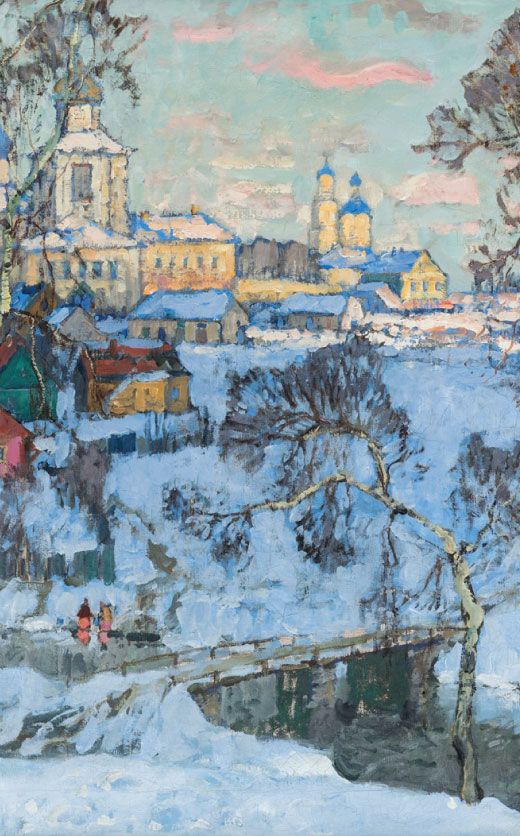20th C. Russian Lidded Vessel Gilt Silver / Cloisonne
Lot 44a
About Seller
Artemis Fine Arts
686 S Taylor Ave, Ste 106
Louisville, CO 80027
United States
Selling antiquities, ancient and ethnographic art online since 1993, Artemis Gallery specializes in Classical Antiquities (Egyptian, Greek, Roman, Near Eastern), Asian, Pre-Columbian, African / Tribal / Oceanographic art. Our extensive inventory includes pottery, stone, metal, wood, glass and textil...Read more
Categories
Estimate:
$1,500 - $2,000
Absentee vs Live bid
Two ways to bid:
- Leave a max absentee bid and the platform will bid on your behalf up to your maximum bid during the live auction.
- Bid live during the auction and your bids will be submitted real-time to the auctioneer.
Bid Increments
| Price | Bid Increment |
|---|---|
| $0 | $25 |
| $300 | $50 |
| $1,000 | $100 |
| $2,000 | $250 |
| $5,000 | $500 |
| $10,000 | $1,000 |
| $20,000 | $2,500 |
| $50,000 | $5,000 |
| $100,000 | $10,000 |
| $200,000 | $20,000 |
About Auction
By Artemis Fine Arts
May 13, 2021
Set Reminder
2021-05-13 12:00:00
2021-05-13 12:00:00
America/New_York
Bidsquare
Bidsquare : Spring Art Auction | Fine, Folk, Fun
https://www.bidsquare.com/auctions/artemis-gallery/spring-art-auction-fine-folk-fun-6949
Featuring visual treats from around the world, and back in time to present day - fine art, folk art, and fun artsy objects. Paintings. Sculptures. Textiles. More. Convenient in-house shipping. Artemis Fine Arts info@artemisgallery.com
Featuring visual treats from around the world, and back in time to present day - fine art, folk art, and fun artsy objects. Paintings. Sculptures. Textiles. More. Convenient in-house shipping. Artemis Fine Arts info@artemisgallery.com
- Lot Description
Eastern Europe, Russia, Moscow, Imperial Period, ca. early 20th century CE. A wonderful high-quality gilt silver and cloisonne lidded jar of vibrant hues. The vessel rests on a concave foot that supports a short neck and the octagonal vessel. The vessel has an elongated form and star-shaped rim. The lid has an interior lip that fits perfectly into the mouth of the vessel. The lid is completed by a protruding handle/finial with four granulated balls surmounted on the top. The stunning cloisonne patterns consist of colorful floral and foliate patterns in hues of red, green, pink, white, and yellow on a blue ground. The rim of the lid is stamped with the maker's mark: "5A" for the 5th Artel artisans. An assay mark known as a kokoshnik is also stamped in this area, consisting of a face in profile to the left of "84." This petite vessel is a remarkable piece of artistry and exemplifies the acclaimed Russian silver and cloisonne techniques. Size: 1.375" W x 3.25" H (3.5 cm x 8.3 cm); quality of silver: 91% to 95%; quality of gold gilt: 0.8% to 2.7%; total weight: 48.2 grams
From the mid-19th century to the early 20th, Russian art of all kinds experienced a renaissance that is known as the Silver Age. Russian artisans were inspired by the Gothic, the Moresque, Chinoiserie, the Baroque, the Rococo - all ornate styles, replete with scrolling vines and flourishing arches. They combined this with the bright colors and rich ornamentation of Old Russian applied art to create a unique style. Later Russian artists in the 20th century recreated the styles pioneered by famous Russian silversmith firms like the Grachev Brothers, Ovchinnikov, Kurlyukov, and the most famous - Faberge.
The artels in Imperial Russia were semi-formal co-operatives of artists and craftsmen skilled in different fields. Of these, the gold, silver, and cloisonne artels are the most revered. However, little is known about the approximately 32 Russian artels which specialized in the production of these pieces. Although many workers were employed at the artels, the pieces produced were the opposite of mass production; in fact, the works from the artel "factories" were highly unique objects or pieces of art of very high quality, and the famous Faberge would commission these artels to produce their designs.
Provenance: ex-collection of James Farmer, Maryland, USA, collected from major galleries and auction houses between 1995 and 2005
All items legal to buy/sell under U.S. Statute covering cultural patrimony Code 2600, CHAPTER 14, and are guaranteed to be as described or your money back.
A Certificate of Authenticity will accompany all winning bids.
We ship worldwide and handle all shipping in-house for your convenience.
#163644Maker marks clearly stamped on lid rim. Areas of dark patina. Minor nicks to enamel. Great condition.Condition
- Shipping Info
-
All shipping is handled in-house for your convenience. Your invoice from Artemis Gallery will include shipping calculation instructions. If in doubt, please inquire BEFORE bidding for estimated shipping costs for individual items.
-
- Buyer's Premium



 EUR
EUR CAD
CAD AUD
AUD GBP
GBP MXN
MXN HKD
HKD CNY
CNY MYR
MYR SEK
SEK SGD
SGD CHF
CHF THB
THB













